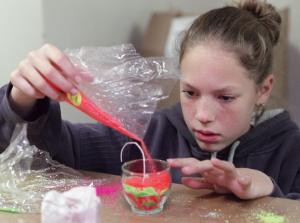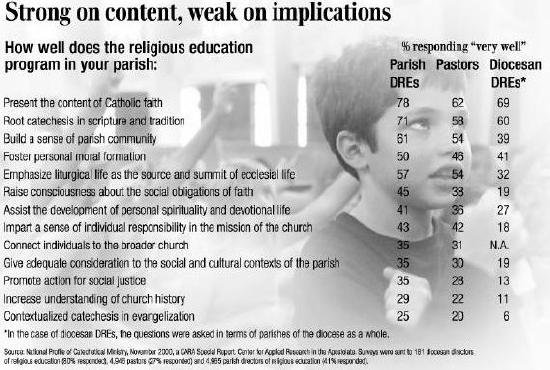Issue Date: March 26, 2004
By DENNIS CODAY Parishes have made great strides in recent years in teaching children the content of Catholic faith and connecting it to scripture and tradition, goals laid out in the “General Directory for Catechesis,” issued by the Vatican in 1997. Yet, in moving to the next level in catechesis -- that is, moving Catholics to a mature and active faith envisioned by the general directory -- parish, diocesan and national catechetical leaders say they are in a tug of war between doing what they say they should be doing and what they say they can do, given staff and budget limitations. In 2000, the Center for Applied Research in the Apostolate -- CARA -- a church think tank at Georgetown University, completed its “National Profile of the Catechetical Ministry.” This survey of 144 diocesan offices of religious education, 4,946 pastors and 4,965 parish directors of religious education found a great deal of success and satisfaction with “traditional classroom-based religious education programs.” It also found a yearning among this survey group to do something more. ‘The 30 hours’ Religious education professionals talk about “the 30 hours.” Thirty hours a year is the average amount of direct contact a catechist has with a student in a typical, once a week, classroom setting that nearly all parish religious education programs in the United States use. “If parish catechesis is limited to the approximately 30 hours available for classroom instruction, it is inadequate,” said Neil Parent, executive director of the National Conference for Catechetical Leadership. Thirty hours of instruction is not enough to get beyond the most basic presentations of content, said Parent, who has been in religious education since 1971. “It just can’t be done.”
The feeling that “you can’t just do it in the classroom” is what drove a lot of the experimentation in religious education in the years immediately after the Second Vatican Council, Parent said. “There was a real attempt to get away from rote memorization of catechetical content with an emphasis on a catechesis that touched the whole person,” he said. Unfortunately, he said, “a lot of the experimentation was not well founded in pedagogical principles. As a result, the rich content [of the Catholic faith] was a casualty of those times.” However, at the same time, teachers of religion were becoming more professional, according to Diana Dudoit Raiche, executive director of the Department of Religious Education at the National Catholic Educational Association. Religious educators began to study more about human development and human learning while asking how faith develops, said Raiche, who has worked at nearly every level of religious education in the church from parish director of religious education to chairperson of a diocesan education commission. What has developed in the ensuing years, she said, is an understanding that religious education is “the passing on of the head and heart of the faith,” meaning that “while there is an intellectual component to religious education that cannot be ignored, knowledge of the faith is more than mere academics.” It was this same sentiment that CARA found in its survey. The study said, “While there is some concern with the limitations of the classroom model, the most common response is to supplement or complement that model rather than replace it wholesale.” The survey found a great deal of experimentation with new formats and models, such as whole community catechesis, family-centered catechesis and intergenerational catechesis. Raiche said that because the typical parish program has very limited contact for direct instruction in the Catholic faith -- the 30 hours -- parish catechists today seek to build “a very close Catholic culture that is good at teaching the faith.” “Young children have to grow up living … as part of a worshiping community and with practicing adults living and make decisions according to their Catholic faith,” she said. “It is what many of us experienced growing up at an earlier time with a Catholic culture well-knitted together.” A new moment According to Parent, these approaches to a more holistic catechesis that teaches the intellectual, content side of faith by taking into account the whole learner and incorporated with the wider community has been in foment for the last several years. “The concepts have been around for 15 years or so,” he said. “What’s different, as I see it, now is that key articulators of how we will do this are coming forward. … [They are] concretizing the concepts and systematizing what has to be done to make this reality.” In practical terms, this means that materials are becoming available for parish level implementers, he said. Publishing houses have made greater efforts at providing parishes with materials to put these concepts into practice. There are now much more structured and systematic ways to make this material available, he said, but added, “We are in the early stages of this.” Parent said advances in today’s catechetical methods are built on two landmark documents: the Catechism of the Catholic Church, promulgated in 1992, and the “General Directory for Catechesis.” These provided a structured framework for the presentation of the content of the beliefs and practices of Catholicism, and as publishers and catechists designed instructional material, they could draw on these resources to ensure they “conformed to the catechism,” he said. For the United States, these universal resources are being “inculturated” into the American church through two forthcoming resources, Parent said. The U.S. bishops have prepared a “National Directory for Catechesis,” the draft of which was sent to Rome for review in fall 2003, and a “popular version” of the catechism that Parent said is aimed at young adult and adult formation. Adult catechesis is a major challenge in the next years, Parent said. “The effectiveness of youth and adolescent catechesis depends on the success of adult religious education.” Raiche agreed. “When adults are well grounded in their faith, the children benefit. The importance of adult formation cannot be underestimated,” she said. However, both national catechetical leaders acknowledge this won’t be easy. “With so much mobility [in society] and so much fragmentation [of the family], you have to try to ground the adults with a good foundation in the faith so they can pass it on to the children. The two have to go hand in hand,” Raiche. “And I have found that parents generally want this and are eager to participate in it.” Parent said the question is “how to do [adult catechesis], especially in these demanding times when their time schedules are so limited. That part is challenging.” “Its still an uphill battle how to make adult education a priority in all our parishes,” he said. Qualified and trained The linchpin in a successful parish religious education program is the person running the show. Parent said he is worried about a decline in the number of qualified and trained catechetical leaders as people with the most experience and advanced degrees age and move out of the field. Until now, religious education programs have been able to draw on religious women and ex-seminarians who had formal training and expertise, Parent said, “but we don’t have those numbers anymore. Typical leaders now are volunteers with no degrees.”
Statistics available aren’t as pessimistic as Parent’s impression, but they do hint at the trend he suggested. A study of catechetical leaders by Tom Walters, a professor of religious education at St. Meinrad School of Theology, found that 66 percent of catechetical leaders are more than 50 years old and have been in the ministry more than 16 years. (Walters also found that 87 percent are women and 86 percent lay). The United States has 19,081 parishes and 195 dioceses or eparchies. A CARA report from November 2000 found that only 60 percent of parishes nationwide have paid directors of religious educations. In one in four parishes, directors of religious education are part-time, and in 15 percent of parishes, the person who fills that role is either a volunteer or the parish priest. Just over half of full-time religious education directors have master’s degrees, in contrast to about a one-third of those who work part-time in that position.
A CARA report from September 2003 found that 42 percent of parish directors of religious education nationwide have a graduate degree in religion or ministry, and 20 percent have no college degree. The report, “Formation of Catholic Lay Ecclesial Ministers for Catechetical Leadership,” looked at institutions that grant advanced degrees. It found that 16,185 men and women were enrolled in schools that offer master’s degrees or certificates in religious education, but only 3,723 (23 percent) of these men and women were enrolled in the religious education program. Most were white, non-Hispanic women (63 percent) between the ages of 40-59. Some training needs are filled by diocesan programs. The CARA report for 2000 revealed that 92 percent and 91 percent of dioceses offer some training for parish catechists and religious education directors respectively. However, the same survey found that only 51 percent of dioceses require such training for catechists and only 44 percent require it for religious education directors. A major cause of the gap between what catechetical leaders want and what they can provide may be the lack of funds (see below). Dennis Coday is an NCR staff writer. His e-mail address is dcoday@natcath.org.
National Catholic Reporter, March 26, 2004 |

